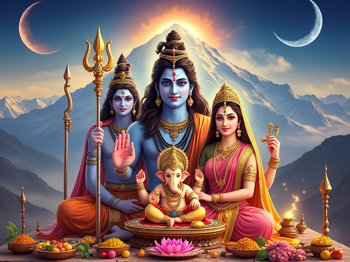-
Symbol of Family Unity: Shiv Parivar represents the perfect family, embodying love, respect, and harmony among its members. The puja reinforces the importance of these values in one's own family life.
-
Divine Protection: The puja invokes the protective blessings of Lord Shiva and his family, safeguarding devotees and their families from negative influences and adversities.
-
Spiritual Growth: Worshiping the Shiv Parivar is believed to aid in spiritual advancement, helping devotees attain inner peace and a deeper connection with the divine.
-
Balance of Energies: The different deities in the Shiv Parivar symbolize various aspects of life—Lord Shiva for destruction of evil and transformation, Goddess Parvati for love and nurturing, Lord Ganesha for wisdom and success, and Lord Kartikeya for courage and strength. Their worship brings a balanced and harmonious energy into the lives of devotees.
- Strengthens family bonds: Promotes unity, love, and understanding within the family.
- Attracts prosperity and success: Blesses the household with wealth and removes obstacles from personal and professional life.
- Ensures good health: Prayers during the puja help protect the family from diseases and enhance overall well-being.
- Promotes peace and happiness: Brings tranquility to the home, fostering a peaceful environment.
- Spiritual fulfillment: Helps devotees on their path to spiritual enlightenment, deepening their connection with the divine.
- Protection from negative forces: Shields the family from evil influences and negative energies.
- Enhances marital harmony: Strengthens the bond between husband and wife, ensuring a happy and stable marriage.
Step-by-Step Procedure to Perform Shiv Parivar Puja
Performing the Shiv Parivar Puja is a deeply spiritual and fulfilling experience. Here’s a step-by-step guide to help you conduct the puja with devotion and sincerity:
1. Preparation
- Choose an Auspicious Day: Select an auspicious day, such as Monday, Pradosh Vrat, or during the month of Shravan, to perform the puja.
- Clean the Puja Area: Clean the area where the puja will be performed. It should be a quiet, clean, and peaceful space in your home.
- Gather Puja Items:
- Idol or picture of Shiv Parivar (Lord Shiva, Goddess Parvati, Lord Ganesha, and Lord Kartikeya)
- Panchamrit (a mixture of milk, yogurt, honey, sugar, and ghee)
- Flowers, especially white and red, and Bel Patra (leaves of the Bael tree)
- Incense sticks (Agarbatti), lamps (Diya), and camphor
- Offerings such as fruits, sweets, dry fruits, and coconut
- Kumkum (vermilion), turmeric, sandalwood paste, and holy water (Gangajal)
- A clean cloth or mat to sit on during the puja
2. Purification
- Personal Purification: Take a bath to purify yourself before beginning the puja.
- Purify the Space: Sprinkle holy water (Gangajal) around the puja area and on the idols or pictures of Shiv Parivar.
3. Setup the Altar
- Place the idol or picture of Shiv Parivar on a clean, elevated platform or altar.
- Decorate the altar with flowers and light a lamp (Diya) in front of the deities.
4. Invocation (Dhyana and Sankalpa)
- Dhyana (Meditation): Sit comfortably and meditate on Lord Shiva and his divine family. Focus on their forms and attributes.
- Sankalpa (Resolution): Make a solemn vow or intention for performing the puja. You can express your wishes and seek blessings for specific aspects of your life, such as health, prosperity, or family harmony.
5. Offerings and Worship (Puja Vidhi)
- Panchamrit Abhishekam: Bathe the idols with Panchamrit, followed by clean water. Wipe them gently with a clean cloth.
- Apply Tilak: Apply sandalwood paste, kumkum, and turmeric on the forehead of each deity.
- Offer Flowers and Bel Patra: Offer fresh flowers and Bel Patra to the deities while chanting the respective mantras for each family member:
- Lord Shiva: "Om Namah Shivaya"
- Goddess Parvati: "Om Parvatyai Namah"
- Lord Ganesha: "Om Gan Ganapataye Namah"
- Lord Kartikeya: "Om Saravanabhavaya Namah"
- Light Incense and Lamp: Light incense sticks and a lamp, and wave them in a circular motion in front of the deities.
- Naivedya (Food Offering): Offer fruits, sweets, and other food items to the deities. You can also offer coconut and dry fruits.
- Aarti: Perform Aarti by waving a camphor-lit lamp in front of the deities while singing or reciting the Aarti song. The Aarti can be concluded by ringing a bell and clapping hands.
6. Mantra Chanting
- Chant mantras and prayers dedicated to Lord Shiva and his family. Reciting the "Maha Mrityunjaya Mantra" and "Om Namah Shivaya" is considered highly auspicious during this puja.
7. Conclusion of the Puja
- Prarthana (Prayer): Offer a final prayer to the Shiv Parivar, seeking their blessings for your family’s well-being.
- Pushpanjali (Flower Offering): Offer a few more flowers at the feet of the deities.
- Prostration (Namaskar): Bow down in front of the deities, showing your respect and gratitude.
- Prasad Distribution: Distribute the prasad (the blessed offerings) to all family members present. Share it with friends and neighbors as well if possible.
8. Post-Puja
- Keep the puja area clean and maintain the sanctity of the place.
- Continue to chant Lord Shiva’s name or mantras throughout the day to keep the divine energy active in your home.
This step-by-step guide should help you perform the Shiv Parivar Puja with devotion and clarity, inviting peace, harmony, and prosperity into your life and home.




